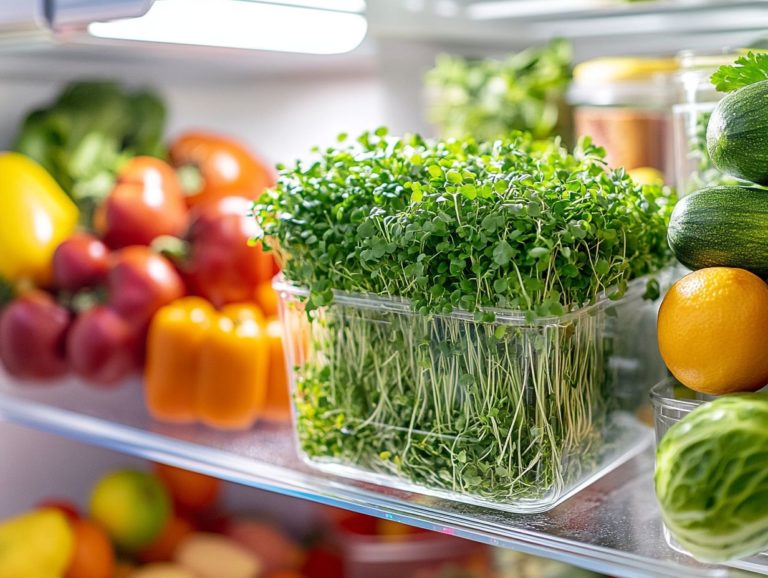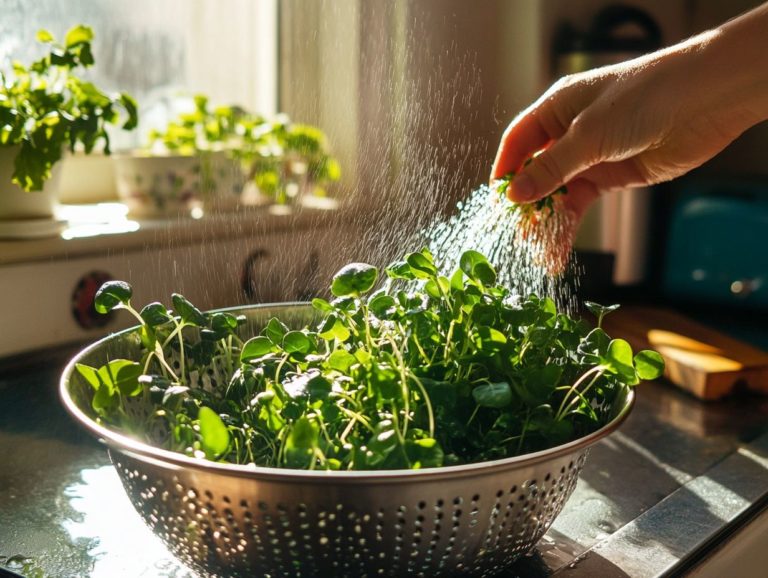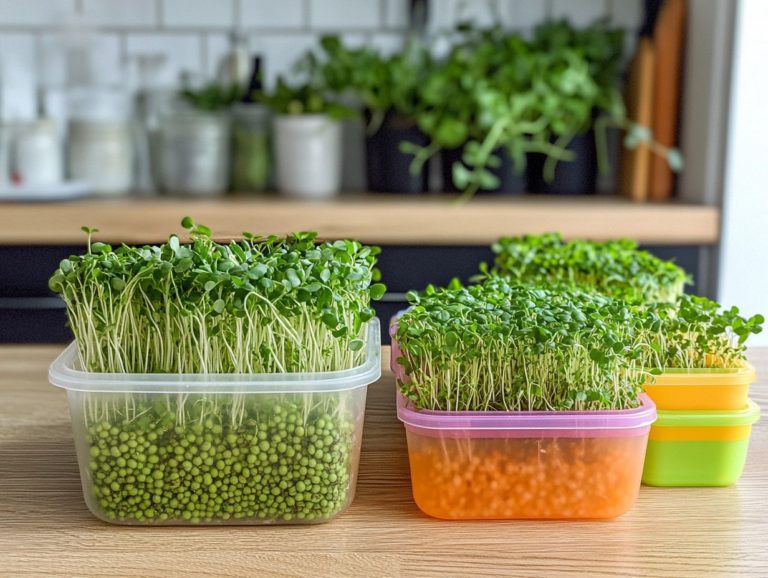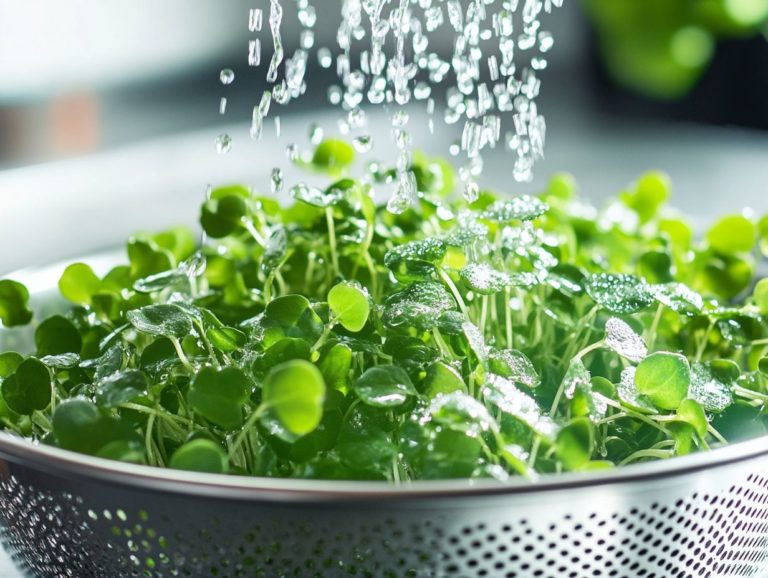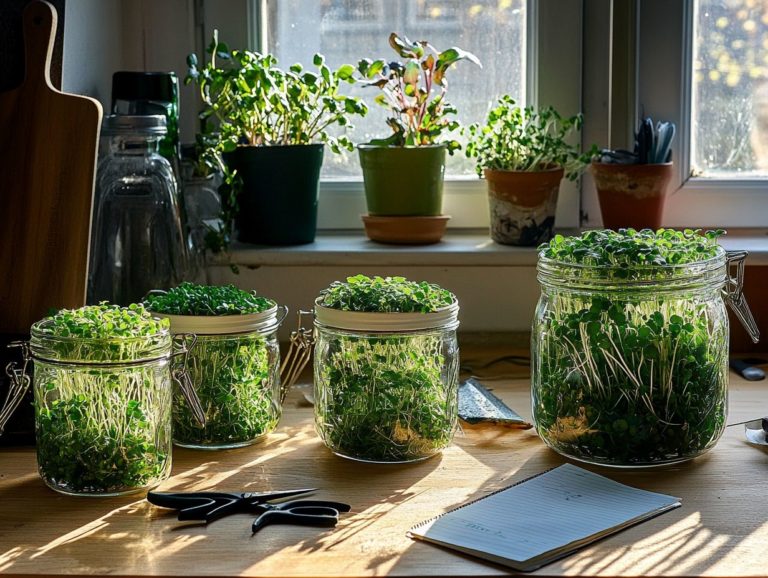The Best Methods for Storing Microgreens
Microgreens are more than just a fashionable garnish; they re a powerhouse of flavor and nutrition.
To truly savor their benefits, proper storage is essential. This discussion delves into the importance of storing microgreens correctly, the factors that influence their freshness, and the best strategies to maintain their vibrancy.
From effective refrigeration techniques to utilizing airtight containers, you ll uncover valuable tips for maximizing their shelf life. Explore how to keep your microgreens fresh and delicious!
Contents
Key Takeaways:
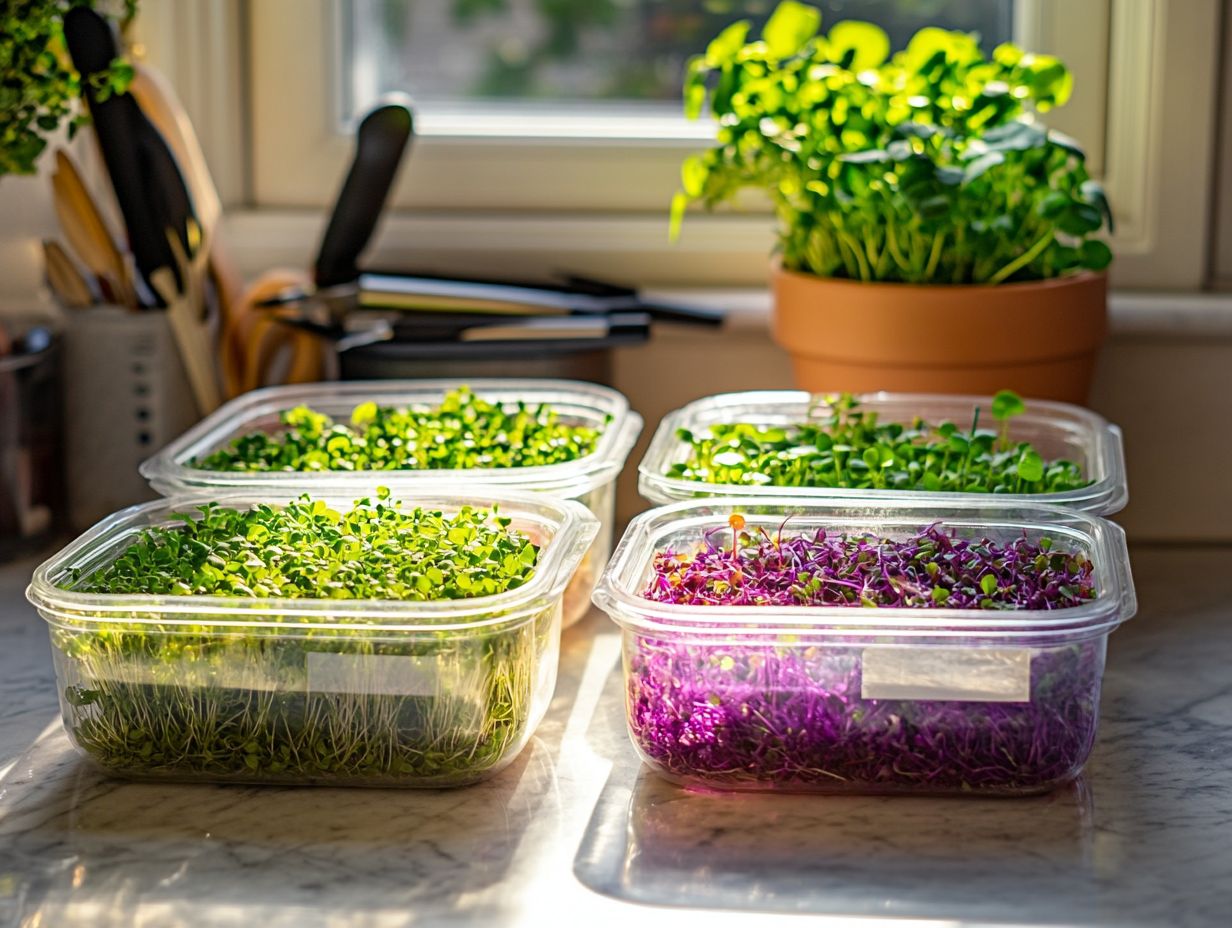
- Maximize shelf life by harvesting microgreens at the right time, using proper cleaning and drying techniques, and storing them in optimal conditions.
- Store microgreens in the refrigerator, root them in water, or use airtight containers to maintain freshness and extend their shelf life.
- Proper storage is crucial for preserving the delicate texture and flavor of microgreens. Factors like temperature, moisture, and air circulation can greatly affect their shelf life.
What are Microgreens?
Microgreens are young, nutrient-packed vegetables, herbs, and legumes harvested just after the first true leaves emerge. These petite greens, hailing from various plant families like Brassicaceae, Asteraceae, and Apiaceae, have skyrocketed in popularity as superfoods due to their impressive profiles of vitamins, minerals, and antioxidants.
They add exciting flavor to your dishes, making them a versatile choice for boosting health benefits in your diet.
With vibrant colors and bold flavors, microgreens come in a delightful variety of types, such as arugula, radish, basil, and cilantro, each offering its own unique taste and nutritional perks. Rich in phytochemicals, these miniature plants can support immune function, improve digestion, and elevate your overall well-being.
Whether you sprinkle them on salads, blend them into smoothies, or use them as a garnish for soups, the culinary possibilities are both vast and thrilling. Their concentrated nutritional content can often outshine that of their mature counterparts, ensuring greater health benefits with every bite. Simply put, they are a must-have in any health-conscious kitchen.
Why Proper Storage is Important
Storing microgreens properly is essential for preserving their freshness, crispness, and nutritional value. By employing the right storage techniques, you can significantly extend their shelf life while ensuring these vibrant superfoods maintain their health benefits, vitamins, and minerals.
This makes them a delightful addition to your salads, sandwiches, smoothies, and soups.
Factors Affecting Microgreen Storage
Several factors play a crucial role in how you store microgreens, including moisture levels, temperature, and airflow. Ensuring adequate airflow is essential as it prevents condensation, which can lead to spoilage. Keeping the temperature just right minimizes ethylene production, a natural gas that ripens fruits and vegetables, helping preserve the freshness and health benefits of these nutritious plants.
Controlling humidity is key, as too much moisture can promote bacterial growth, compromising both the flavor and nutritional integrity of your greens. The choice of container also matters; using sprouting trays for microgreens can influence light exposure, which affects the metabolism of the microgreens.
Creating low-light conditions helps reduce energy consumption and slows down metabolic rates, ultimately extending their shelf life. Don’t overlook the importance of storage location, whether it’s a cool cabinet or a designated section of your fridge. For optimal care, consider watering techniques for thriving microgreens. The right environment is vital for maintaining ideal conditions, ensuring that your microgreens retain their vibrant colors and rich nutrient profiles for as long as possible.
Best Methods for Storing Microgreens
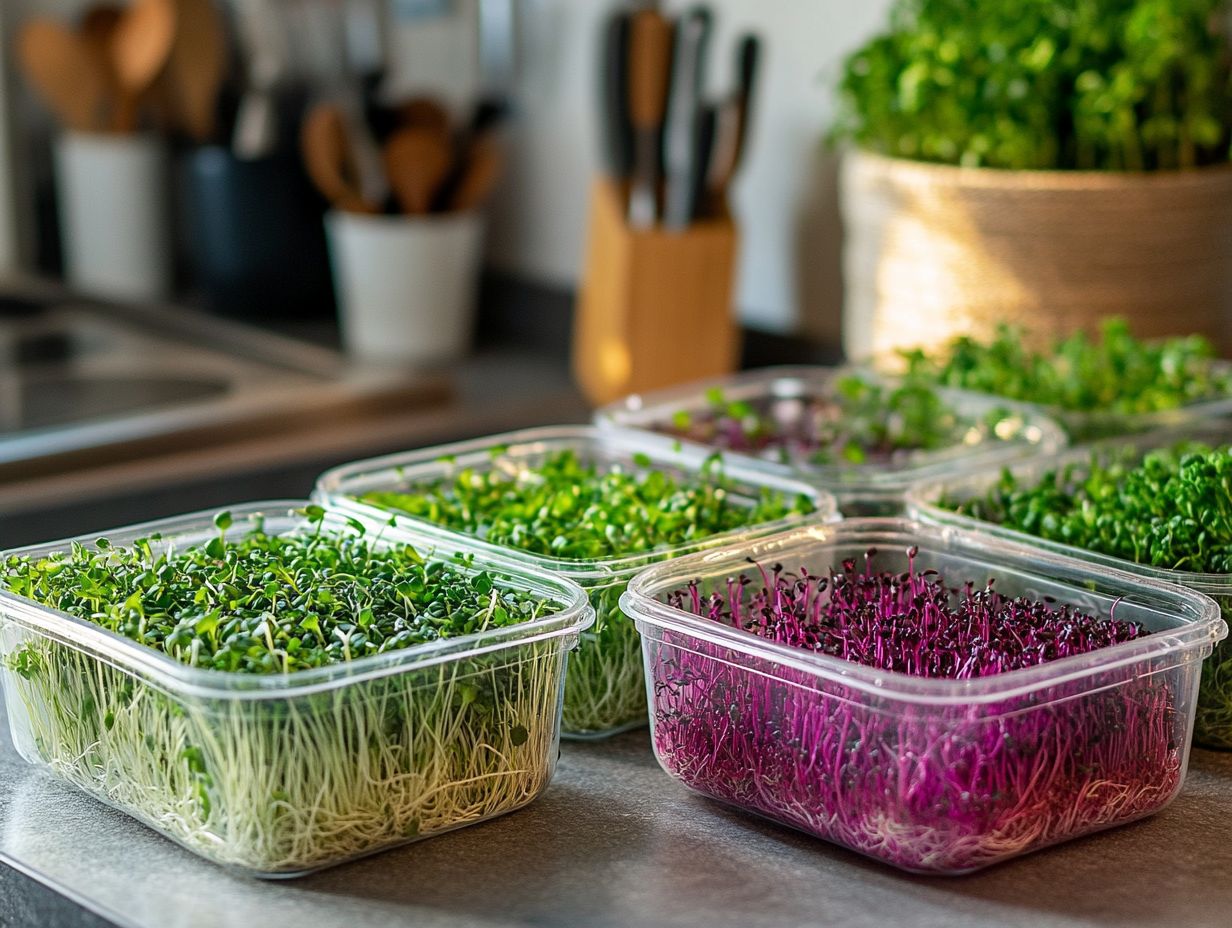
To guarantee the longevity and quality of your microgreens, you can employ several effective storage methods. Consider using resealable bags, biodegradable containers, or vacuum-sealed packaging.
These options not only help preserve freshness but also protect these delicate greens from moisture and environmental factors that could compromise their health benefits.
Refrigeration
Refrigeration is one of the best ways to store microgreens. It helps control temperature and moisture, keeping these delicate greens crisp. A cool environment slows spoilage and preserves their valuable nutrients and health benefits.
Aim for a refrigeration temperature range between 32 F (0 C) and 41 F (5 C). This minimizes spoilage processes and prevents harmful bacteria growth, enhancing flavor while extending the shelf life of these nutrient-packed greens.
Keep microgreens away from ethylene-producing fruits like bananas and apples. Exposure to these fruits can cause premature wilting and reduce quality. When stored correctly, microgreens remain vibrant and nutrient-rich, making them a superb addition to any meal.
Rooting in Water
Rooting microgreens in water is a fantastic storage technique that extends freshness. This method allows greens to absorb moisture directly, enhancing their crispness and encouraging further growth.
To start, place the cut stems in a shallow container filled with water. Choose a mix of microgreens like basil, arugula, or broccoli and trim the stems at an angle for better water absorption. For those interested in growing microgreens even in colder months, consider these tips for growing microgreens in winter. Ensure the water covers the bottom inch of the stems, but keep the leaves above water to prevent rot. Change the water every couple of days to keep it fresh.
This technique not only preserves your greens but also enhances the flavor profiles of your dishes, turning meals into vibrant experiences. You ll find that maintaining microgreens this way keeps them edible longer and allows for the growth of additional shoots to harvest later.
Using Airtight Containers
Using airtight containers is a smart way to store microgreens. They significantly reduce exposure to moisture and air, which can compromise freshness and flavor. This method preserves vitamins and antioxidants, ensuring microgreens remain nutritious.
When selecting airtight containers, choose materials like glass or BPA-free plastic that won t retain odors or flavors. Incorporating breathable liners can also help maintain optimal moisture levels.
As you seal the containers, remove as much air as possible to create a vacuum-like environment. Regularly check the seals and store them in a cool, dark place to prevent degradation.
This approach keeps your microgreens fresh and vibrant for longer, especially when you ensure the perfect light conditions for microgreens, making them an appealing addition to various dishes.
Tips for Maximizing Shelf Life
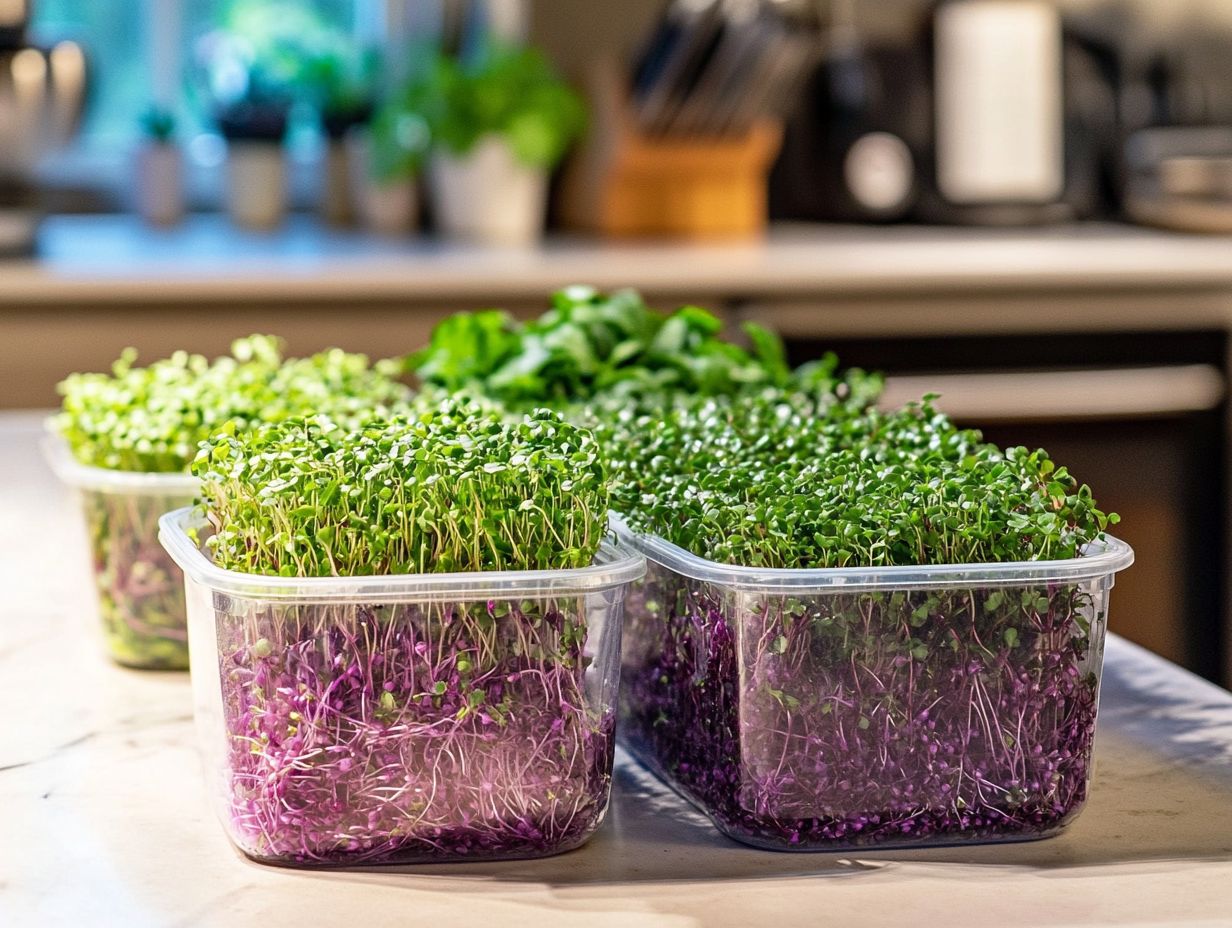
To maximize the shelf life of your microgreens, start with careful harvesting and meticulous post-harvest handling. Use effective cleaning and drying techniques in your routine.
These steps are crucial for preserving freshness and nutritional value, ensuring microgreens remain a delightful and healthy enhancement to your meals.
Harvesting at the Right Time
Harvesting microgreens at the right moment unlocks their peak flavor and maximizes health benefits. The timing depends on the specific variety, as each has its own optimal maturity for harvesting.
For example, pea shoots are best when they reach about 3 to 4 inches tall, offering a sweet flavor that elevates many dishes. Radish microgreens can be harvested as soon as their delicate leaves begin to unfold, providing a spicy kick for salads and sandwiches.
Watch for vibrant green leaves to signal readiness; faded or wilting foliage suggests they ve missed their prime. Properly identifying these indicators ensures a delightful culinary experience while maximizing the health benefits of these nutrient-dense greens.
Proper Cleaning and Drying Techniques
Implementing proper cleaning and drying techniques is essential for preserving the freshness and quality of your harvested microgreens. Gently rinsing the greens and ensuring they are thoroughly dried will help eliminate excess moisture, a primary contributor to spoilage.
To start, it s advisable to use a fine-mesh sieve or colander to rinse your microgreens under cool, running water. This process not only removes lingering dirt but also revitalizes their crispness.
After rinsing, pat the greens dry with a clean kitchen towel. Alternatively, use a salad spinner to remove water without bruising the delicate leaves.
Maintaining optimal moisture levels is crucial. Excess water can lead to wilting or fungal growth, compromising both flavor and shelf life.
Once dried, spread the microgreens on a clean dish towel or paper towel for a brief period. This ensures thorough air circulation before storage. This simple step boosts the quality, making every bite a delight!
Storing in Optimal Conditions
Storing microgreens in optimal conditions is crucial for their longevity and health benefits. By maintaining the right temperature and humidity levels, you can significantly enhance their freshness and overall nutrient retention.
To achieve the ideal storage environment, target a temperature between 33 F to 40 F (1 C to 4 C). This cool range slows down natural processes, helping microgreens retain their flavor and nutrients longer.
Regulating humidity levels is just as important; aim for around 40-60% humidity to prevent wilting while avoiding excess moisture that can lead to mold. Using breathable containers helps you achieve these optimal humidity levels.
By regularly monitoring these conditions, you can ensure that your delicate greens remain healthy, crisp, and full of life for extended periods. This enhances both your culinary creations and your overall nutrition.
Frequently Asked Questions
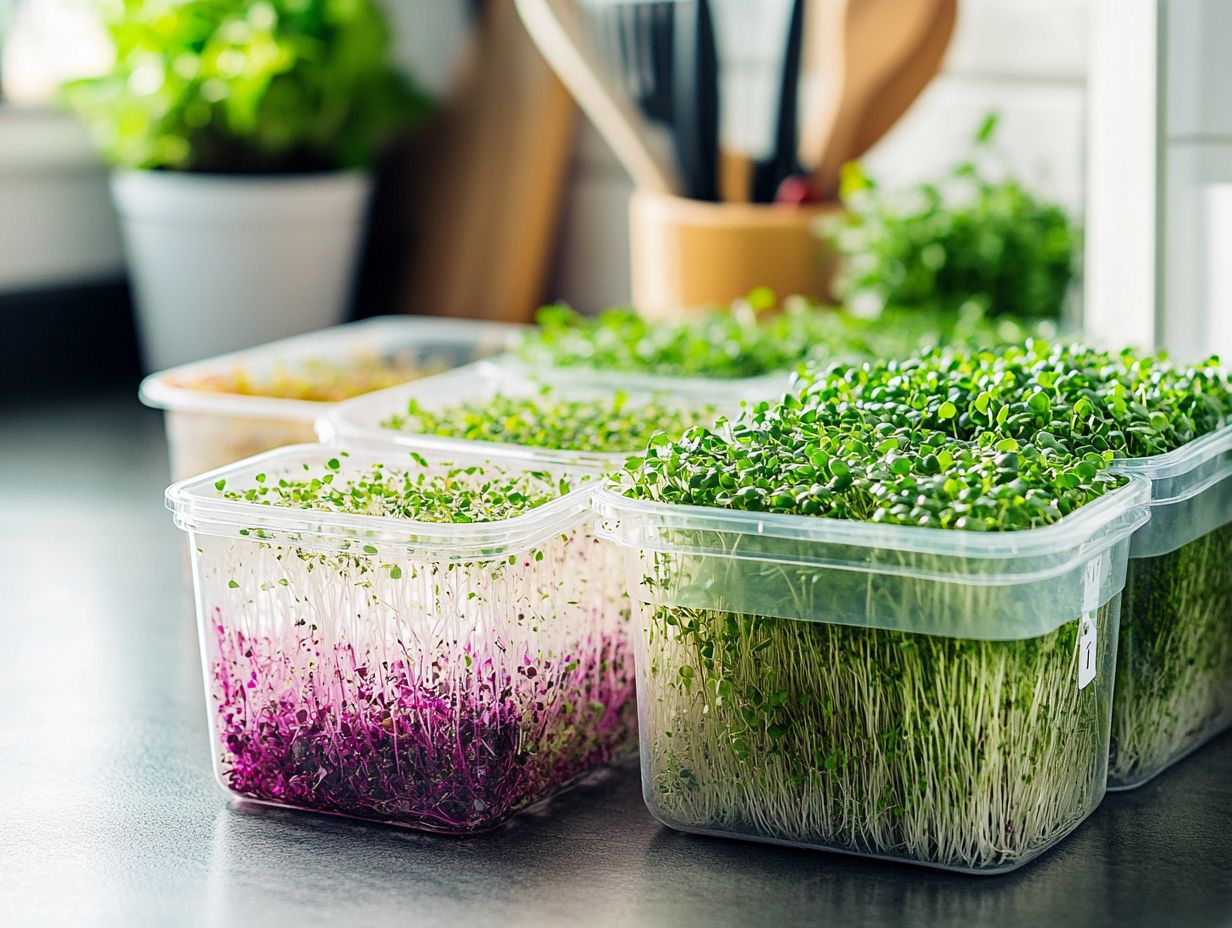
What are the best methods for storing microgreens?
The best methods for storing microgreens include refrigeration, using airtight containers, and controlling moisture.
How should I store microgreens in the refrigerator?
You can store microgreens in the refrigerator by placing them in a sealed container lined with paper towels. This absorbs excess moisture, preventing spoilage.
Can I freeze microgreens for storage?
While freezing microgreens is not recommended, blanching them before freezing can help retain some nutrients. However, the texture and flavor may be compromised.
What is the ideal temperature for storing microgreens?
Keep your microgreens at a chilly 32-40 F (0-4 C) to keep them fresh! This helps slow the growth of bacteria and fungi, extending shelf life.
How long can microgreens be stored?
Microgreens can be stored for 5-7 days if properly refrigerated in airtight containers with moisture control. Some hardier varieties may last up to 10 days.
Can I store different types of microgreens together?
It is not recommended to store different types of microgreens together. They may have different moisture and storage requirements, so it is best to keep them separate to maintain quality and freshness.
Try these methods today and enjoy the freshest microgreens in your meals!

